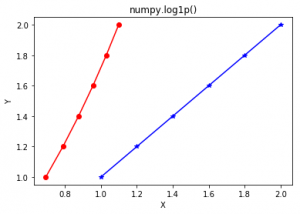Python numpy.log()
numpy.log()是一个数学函数,帮助用户计算x的自然对数,其中x属于所有的输入数组元素。
自然对数log是exp()的逆数,所以log(exp(x))=x。 自然对数是以e为底的log。
语法 : numpy.log(x[, out] = ufunc ‘log1p’)
参数 :
array :[array_like] 输入数组或对象。
out :[ndarray, optional] 输出数组的尺寸与输入数组相同,与结果放在一起。
返回 :
一个具有自然对数值x的数组;其中x属于输入数组的所有元素。
**代码 #1 : **
# Python program explaining
# log() function
import numpy as np
in_array = [1, 3, 5, 2**8]
print ("Input array : ", in_array)
out_array = np.log(in_array)
print ("Output array : ", out_array)
print("\nnp.log(4**4) : ", np.log(4**4))
print("np.log(2**8) : ", np.log(2**8))
输出 :
Input array : [1, 3, 5, 256]
Output array : [ 0. 1.09861229 1.60943791 5.54517744]
np.log(4**4) : 5.54517744448
np.log(2**8) : 5.54517744448
代码#2:图形化表示
# Python program showing
# Graphical representation
# of log() function
import numpy as np
import matplotlib.pyplot as plt
in_array = [1, 1.2, 1.4, 1.6, 1.8, 2]
out_array = np.log(in_array)
print ("out_array : ", out_array)
plt.plot(in_array, in_array,
color = 'blue', marker = "*")
# red for numpy.log()
plt.plot(out_array, in_array,
color = 'red', marker = "o")
plt.title("numpy.log()")
plt.xlabel("out_array")
plt.ylabel("in_array")
plt.show()
输出 :
out_array : [ 0. 0.18232156 0.33647224 0.47000363 0.58778666 0.69314718]

 极客教程
极客教程